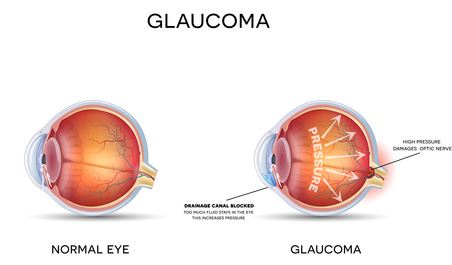Glaucoma is a disease involving the optic nerve that affects the loss of retinal ganglion cells. If glaucoma is left untreated it will eventually lead to permanent damage of the optic nerve and then blindness. Glaucoma is caused most commonly by intraocular pressure on the nerves in the eye. A damaged visual field can never be fixed or recaptured. Glaucoma is a tricky disease because its progression is so slow. It can gradually wear down one’s eyesight without the person noticing much of a difference and once the disease is detected; there isn’t much a doctor can do to prevent it from getting worse, because it was detected at such a late stage.

People with ocular pressure, diabetes, and African American decent are three times more likely than others to develop Glaucoma. People that have a family history of Glaucoma have a six percent chance to develop the disease than people without a family history of it. The use of steroids has also been linked to the development of Glaucoma. Studies have also shown, in rare cases, that Glaucoma could be linked to hypertension (high blood pressure).
Glaucoma is usually diagnosed after a routine eye examination with an optometrist or ophthalmologist. The doctor will test the eye for changes in intraocular pressure, changes in the size or shape of the eye and an examination of the optic nerve. Glaucoma could also be examined by looking at the patient’s background; their sex, race, history of drug use, refraction, inheritance and family history. The majority of treatments for Glaucoma is the continued use of eye drops to help lower the level of intraocular pressure.
There is yet to be a cure for Glaucoma but surgery is one way to treat the disease. The surgery will help to lower intraocular pressure by allowing fluid to leave the eye after a hole has been opened up in the meshwork. Surgery can be performed with a laser or conventionally. A patient could also undergo a canaloplasty. A canaloplasty is when the Schlemm Canal is opened, allowing fluids to flow freely, ultimately lowering the pressure of the eye. Glaucoma patients that don’t respond to these normal treatments could look into Glaucoma drainage implants. This is the final option for patients if the eye does not respond to any other treatment. A flow tube is inserted in the eye to allow for fluid to flow out of the eye, thus lowering the intraocular pressure.
There are a handful of different stages of Glaucoma. They are primary, developmental, secondary and absolute Glaucoma. All of these stages develop over time and can eventually lead to blindness if the disease is not treated properly. Not all people with elevated pressure in the eye develop Glaucoma. Some patients of Glaucoma have developed the disease without elevated pressure in the eye. This could just be from their family history. In fact, the most common type of Glaucoma disease is hereditary. Everyone is at risk for the disease and in most cases there are little to no symptoms.
Article submitted by Brenda Williams.









Join the Discussion
Type out your comment here:
You must be logged in to post a comment.